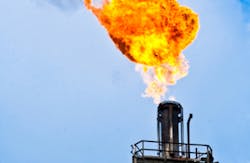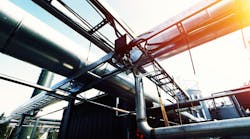Thermal flowmeters work by introducing heat into the flowstream and measuring how much heat dissipates, using one or more temperature sensors. There are two different methods for doing this. One method is called the constant temperature differential. Thermal flowmeters that use this method have two temperature sensors. One is a heated sensor and the other sensor measures the temperature of the gas. Mass flowrate is calculated based on how much electrical power is required to maintain a constant temperature difference between the two temperature sensors.
The second method is called a constant current method. Under this method, thermal flowmeters also have two sensors—one heated sensor and one that measures the temperature of the flowstream. Power to the heated sensor is kept constant, and mass flow is measured based on the difference between the temperature of the heated sensor and the temperature of the flowstream. Both methods make use of the principle that higher velocity flows result in greater cooling. Both methods compute mass flow by measuring the effects of cooling on the flowstream.
READ ALSO: The History & Evolution of Thermal Flowmeters
Thermal flowmeters have benefited greatly over the years from governmental requirements to monitor flare, stack gas, and greenhouse gas emissions. In the early 1990s, the need for continuous emissions monitoring (CEM) required measurement of sulfur dioxide (SO2) and nitrous oxide (NO2). This measurement was made by combining a measurement of the concentration of SO2 and NO2 with a measurement of flowrate. At that time, thermal flowmeters competed with multipoint averaging Pitot tubes and ultrasonic flowmeterst.
The broad acceptance of global warming as a cause of climate change has presented a second opportunity for thermal flowmeters. Since the election of the Obama administration in 2008, the U.S. government has made the identification and reduction of greenhouse gases a major priority. The administration has stated as a goal to reduce greenhouse gases by 80 percent by 2050. Many other countries have also made greenhouse gas reduction a priority. The Kyoto Accord has resulted in the creation of several mechanisms for the international measurement of greenhouse gases.
For more information on Flow Research’s work in the area of thermal flow measurement, visit www.FlowThermal.com.



